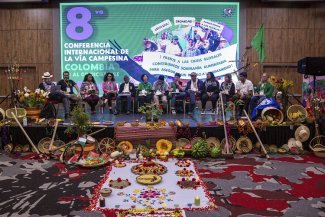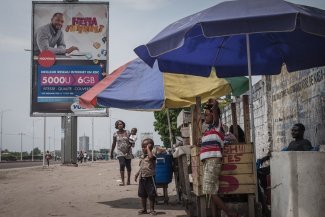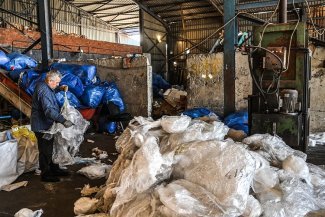There are an estimated 40.3 million victims of forced labour in the world, 71 per cent of whom are women, according to the International Labour Organization. Thanks to technology, traffickers are not only able to exploit more people but they can also go about it with greater stealth.
Daniela (not her real name) is a young Bulgarian woman who, like so many other young people of her generation, shares every minute of her life on Facebook. A man, slightly older than her, sent her a friend request. They chatted, a lot. Above all, he was able to track her every move, to observe her day-to-day routines. Just a few clicks gave him access to her whole life. One day, Daniela ran into him on the street in Bulgaria. Within no time, he had kidnapped her, confiscated her phone and raped her. He then took her to France, where he forced her to beg. She managed to break free thanks to an older lady who regularly visited the bakery that she was begging in front of and who had noticed how unwell she was.
This sadly all too common story, told by Nagham Hriech Wahabi, a psychologist at OICEM, a French organisation working to combat modern slavery, is an archetypal example of how human traffickers use new technologies. Whilst the use they make of Facebook is still quite basic, other more sophisticated uses of technology include fake job offers to lure young people to other countries, cryptocurrency transactions, GPS to track the people exploited in real time, etc.
Their modus operandi is constantly evolving, as shown in Leveraging innovation to fight trafficking in human beings: a comprehensive analysis of technology tools, a report published in June 2020 by the Organization for Security and Cooperation in Europe (OSCE) and Tech Against Trafficking, an initiative involving multinationals such as Amazon, Microsoft and the US telecommunications giant AT&T.
The coalition’s mission is “to advance and scale the use of technology to prevent, disrupt, and reduce human trafficking and increase and expand survivors’ access to resources”. The report was released a month ahead of World Day Against Trafficking in Persons on 30 July.
The fight against trafficking in human beings is all the more difficult given the diversity of forms it can take: ranging from individual cases such as the South Sudanese family who auctioned off their underage daughter on Facebook to the international networks of human trafficking rings. According to the United Nations definition, human trafficking is the “recruitment, transportation, transfer, harbouring or receipt of persons by improper means (such as force, abduction, fraud, or coercion) for an improper purpose including forced labor or sexual exploitation”. It can range from the smuggling of migrants across the Mediterranean under atrocious conditions to the recruitment of young au pairs who are turned into modern-day slaves.
It is essential that the scale of the problem should not be obscured by its diversity: there are an estimated 40.3 million victims of forced labour in the world, 71 per cent of whom are women, according to the International Labour Organization (ILO). Moreover, as the report explains at length, “while human traffickers are becoming more tech-savvy and are able to use technology successfully to their advantage, the same is not necessarily true of actors responsible for combatting trafficking in human beings”.
Exploiting more people whilst running less of a risk
As is often the case in the world of crime, it is the criminals that set the pace, whilst the investigators adapt to keep up with them, before their tools become obsolete. But in this case, the balance of power is clearly tipped in the people traffickers’ favour. Thanks to technology, traffickers are not only able to exploit more people but they can also go about it with greater stealth.
The report mentions the private groups with thousands of members on encrypted applications such as Telegram and Whatsapp being used to advertise sex tours in various countries or the possibility of hiring a sex worker for a month. The Uruguayan justice system, for example, recently uncovered a network for the sexual exploitation of teenage girls, allegedly involving around 20 businessmen and influential people. These groups can only be joined by invitation or referral, which protects the identity of its members. The Dark Web is also a platform favoured by criminal networks for its confidentiality, being used for illegal activities such as child pornography.
Hriech Wahabi, who has been a member of the French anti-slavery organisation OICEM since 2007, points out that traffickers also use the internet to keep a constant grip on their victims.
“Traffickers threaten to send humiliating videos or photos to the friends or families of women forced into prostitution. Even if the exploitation takes place far from their region of origin, a trace can be left, sometimes forever,” she tells Equal Times. The risk of being shamed by images is added to the painful memories.
The OSCE and Tech Against Trafficking analysed 305 tech tools and initiatives designed to combat trafficking more effectively. The aims are as wide and varied as the sources of the funds financing their development: some are funded directly by governments, others by NGOs, but a significant proportion (40 per cent) of these tools are developed by the private sector. One example is the French company Ecovadis, which offers companies a system for assessing their corporate social responsibility (CSR), such as checking to ensure that no child is exploited by the subcontractors of a multinational company.
Another tool identified in the long list presented in the report is the Slavery From Space site developed by the University of Nottingham to identify, via satellite images, brick kilns in south Asia, and particularly in India. These key sites accompanying the fast-paced growth of south Asian cities are also places where an estimated 68 per cent of workers are forced labour and about 19 per cent are children under the age of 18. Using this tool, volunteers have analysed some 400 images provided by Google Maps and the university is now trying to replicate the experiment with more precise tools.
In spite of these interesting new tools, which sometimes lead to concrete results, as Radu Cucos, the author of the OSCE report points out to Equal Times: “We are always one step behind the traffickers. For the moment, we are not able to say that we are making much progress in this fight.” His assessment is based on the exponential rise in profits from human trafficking over the last 15 years. “In 2005, the ILO put the profits from forced labour and sexual exploitation at about US$31.6 billion a year. By 2014 the profits had reached US$150 billion a year,” he explains.
“The technology to combat human trafficking is there,” says Cucos. What we need to do now, as he underlines in the report, is “to move beyond the cycle of developing and piloting new initiatives, and toward expanding the coverage of those existing initiatives that are showing results”. That requires long-term funding for the tools and initiatives available. Many of the websites linked to the tools presented in the report were down when Equal Times visited them, just two weeks after the report was published.
Expanding the use of pre-existing tools
“The tools need to be constantly updated,” says Hriech Wahabi. If anyone uses one of these tools to report abuse or ask for help but does not receive an immediate response, they could feel like they have hit a wall. Another danger, to quote Hriech Wahabi, is the “overproduction” of tools. “People no longer know what to do, who to turn to, and it becomes counterproductive. It would be interesting to develop tools hand-in-hand with the victims, to come up with straightforward, practical solutions,” she says.
Although trafficking affects people all around the globe, it is striking that the majority of the tools are in English and sometimes in English alone. Some target a particular geographical area, such as the educational game developed for Balkan countries, which explains the mechanisms surrounding human trafficking and has been translated into English, French, Russian and six other Balkan languages, making it better equipped to meet its purpose.
One way of achieving greater effectiveness is cooperation between the various stakeholders in the fight against trafficking in human beings.
Bénédicte Lavaud-Legendre, a researcher attached to the University of Bordeaux, has developed a tool that would make it possible to map the links between the various actors involved in trafficking operations. More specifically, the tool makes it possible to identify the role of each person, the entourage of each procurer or person prostituted, for example, and to classify these links as financial, criminal or family ties. The researcher does not intend to stop there: “We are currently responding to a European call for projects as part of a group bringing together investigators, NGOs and researchers,” she explains. This tool, if selected, would make it possible to aggregate all the knowledge on the subject of human trafficking while allowing keyword searches to compare the cases encountered by actors in the field.
Hriech Wahabi has her reservations about the proliferation of such tools. “There is less funding for day-to-day support than for producing visual tools that are only used once.” To address this problem, institutions are pushing for coordination between the various actors in the fight against trafficking. More dialogue is needed between NGOs, investigators, researchers and governments to ensure better support for the victims and to achieve the goal set by UN member countries to eradicate all forms of forced labour and to end modern slavery and human trafficking by 2030.










